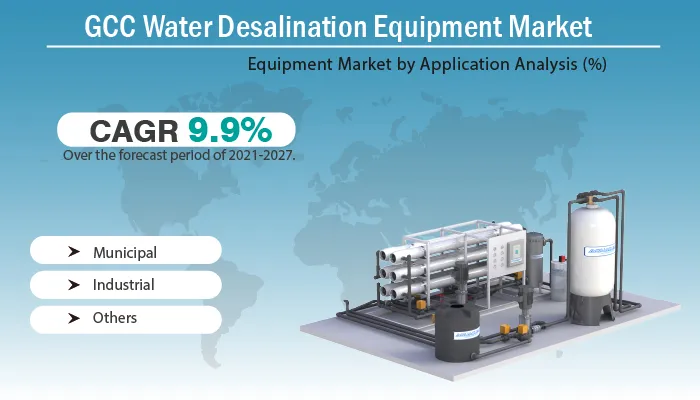GCC Water Desalination Equipment Market (Technology - Reverse Osmosis (RO), Multi-stage Flash Distillation (MSF), Multi-effect Distillation (MED), and Others; Application - Municipal, Industrial, and Others): Industry Analysis, Trends, Size, Share and Forecasts to 2027
A recent report published by Infinium Global Research on the water desalination equipment market provides in-depth analysis of segments and sub-segments in the GCC as well as regional water desalination equipment market. The study also highlights the impact of drivers, restraints, and macro indicators on the GCC and regional water desalination equipment market over the short term as well as long term. The report is a comprehensive presentation of trends, forecast and dollar values of GCC water desalination equipment market. According to the report, the GCC water desalination equipment market is projected to grow at a CAGR of 9.9% over the forecast period of 2021-2027, growing from nearly USD 2363 million in 2020 to about USD 4567 million in 2027.

Market Insight
The desalination process converts the saline water into fresh water that is potable, and safe for domestic use. Desalination involves taking away the salt from seawater and filtering it to give drinking quality water. The process has come up as a promising substitute for fresh water in water-scarce regions. Desalination offers a sustainable supply of fresh water with the required quantity and quality. A continued supply of high-quality drinking water for consumption is possible with desalination, even during periods of drought. It also provides an alternative source of water that will make our overall supply more diverse and less vulnerable to interruption. The Middle East region is heavily dependent on the desalination of seawater due to the scarcity of fresh water in the region. The GCC countries are at the forefront of the water desalination industry.
The COVID-19 pandemic has severely affected the economy in the GCC region. The GCC countries registered a large number of COVID-19 cases during 2020. The governments imposed strict regulations on people and organizations. The pandemic increased the demand for fresh water in the GCC region. Providing clean drinking water to the citizens during the pandemic was one of the major priorities for the governments. Thus, the governments increased the water desalination capacity of the plants. Moreover, maintaining hygiene to control the pandemic was another priority for the governments across GCC. Providing clean water for domestic purposes other than drinking such as cleaning, and washing is also important for hygiene. This clean water is produced from desalination plants. This, in turn, augmented the market growth during the pandemic. Furthermore, as the pandemic subsides, the demand for desalination is anticipated to increase further.
The freshwater scarcity in the region is majorly driving the growth of the GCC water desalination market. The GCC region is one of the driest places in the world. The average rainfall in the region ranges between 20-40 cm per year and droughts are frequent in the region. Thus, freshwater is scarcely available in nature, and the seawater has to be desalinated to have fresh water. Moreover, the population in the GCC region is increasing at a rapid rate, augmenting the demand for freshwater. The growing demand for freshwater is satisfied by the desalination plants. However, the desalination process is energy-intensive and emits a large amount of carbon into the air. This makes the desalination process harmful for the environment, leading to an air population. The carbon emission from the desalination process is expected to hamper the market growth. Nevertheless, the development of innovative desalination technologies is anticipated to boost the market over the forecast period.
In terms of country, the GCC water desalination market is segmented into Bahrain, Kuwait, Oman, Qatar, Saudi Arabia, and the United Arab Emirates. Among these countries, Saudi Arabia accounted for the largest share in the GCC water desalination market. Saudi Arabia is the largest country in the GCC in terms of population, having more than 35 million living in the country. More than 70% of the country’s water requirement is satisfied by desalinated water. The large population in the country increases the demand for freshwater. Moreover, Saudi Arabia has some of the leading water desalination companies in the region. This, in turn, further augments the market growth.
Segment Covered
The report on GCC water desalination equipment market covers segments such as technology, and application. On the basis of technology, the sub-markets include reverse osmosis (RO), multi-stage flash distillation (MSF), multi-effect distillation (med), and others. On the basis of application, the sub-markets include municipal, industrial, and others.
Companies Profiled:
The report provides profiles of the companies in the market such as Veolia Environnement SA, Biwater Holdings Limited, Acciona, S.A., ACWA Power International, and Saline Water Conversion Corporation, AquaTreat Group, Marafiq Power and Water Utility Company, Lenntech B.V., Aquatech International LLC, and TMW Technologies.
Report Highlights:
The report provides deep insights into the demand forecasts, market trends, and micro and macro indicators. In addition, this report provides insights into the factors that are driving and restraining the growth in this market. Moreover, The IGR-Growth Matrix analysis given in the report brings an insight into the investment areas that existing or new market players can consider. The report provides insights into the market using analytical tools such as Porter's five forces analysis and DRO analysis of water desalination equipment market. Moreover, the study highlights current market trends and provides forecast from 2021-2027. We also have highlighted future trends in the market that will affect the demand during the forecast period. Moreover, the competitive analysis given in each regional market brings an insight into the market share of the leading players.
